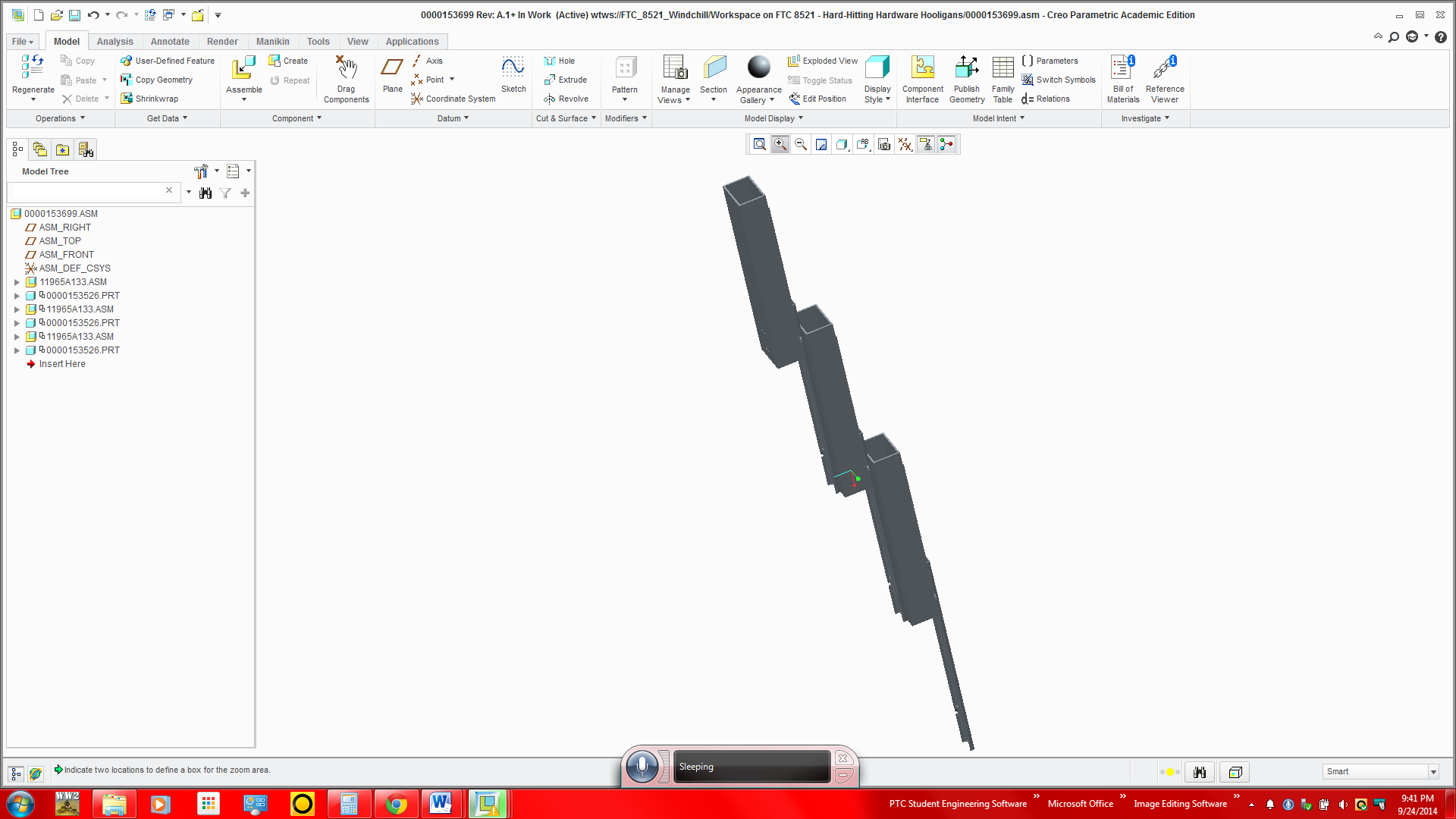Community Tip - Visit the PTCooler (the community lounge) to get to know your fellow community members and check out some of Dale's Friday Humor posts! X
- Community
- PTC Education
- PTC Education Forum
- Re: Multiple Slider Constraints
- Subscribe to RSS Feed
- Mark Topic as New
- Mark Topic as Read
- Float this Topic for Current User
- Bookmark
- Subscribe
- Mute
- Printer Friendly Page
Multiple Slider Constraints
- Mark as New
- Bookmark
- Subscribe
- Mute
- Subscribe to RSS Feed
- Permalink
- Notify Moderator
Multiple Slider Constraints
We are trying to design a lift that uses multiple linear slides to obtain a certain height. We have constrained all of the linear slides in such a way that they should all be able to extend and collapse using the "Drag Components" command. What we actually get is the 1st linear slide (the lowest slide) moves, but the 2nd and 3rd slides will not move. We have attached the files in a ZIP folder. Please keep in mind that we downloaded the linear slide model off of McMaster-Carr (link inserted below) and was imported using a .STEP file format. We then reconfigured the .STEP file to animate, and it works in the sub-assembly of just the linear slide. The linear slide we downloaded was the 16" version. Please feel free to ask us any questions about our description of the problem. Does anyone have any suggestions?

MCMASTER-CARR LINK:
http://www.mcmaster.com/#11965a133/=tvb3bx
Solved! Go to Solution.
Accepted Solutions
- Mark as New
- Bookmark
- Subscribe
- Mute
- Subscribe to RSS Feed
- Permalink
- Notify Moderator
Hi!
After a little bit of wrestling with it, I finally got this to work. I believe the issue stems from how the slider mechanism was originally set up. If you go and look at the assembly 0000153175.asm and try to move the slide, you will see that it comes flying off. I'm not sure how this happened but I believe that it was an issue with import.
To fix it, all I did was re-assemble 0000153175.asm so that it worked as intended. I then deleted the assembly 11965A133.asm because it is just a copy of 0000153175.asm and recreated your assembly (using 000153175 instead of 11965A133 obviously). I made sure that the beginning slider was set to default and assembled the remainder of the parts as static (we already created the mechanism in 0000153175).
When I rebuilt the 0000153175 mechanism I did it quickly (and sloppy) so I would highly recommend checking all of the assembly dimensions to the ones located on attached PDF. This will ensure that the slider actually slides as long as it should.
Please let me know if you have any questions!
- Mark as New
- Bookmark
- Subscribe
- Mute
- Subscribe to RSS Feed
- Permalink
- Notify Moderator
Hi!
After a little bit of wrestling with it, I finally got this to work. I believe the issue stems from how the slider mechanism was originally set up. If you go and look at the assembly 0000153175.asm and try to move the slide, you will see that it comes flying off. I'm not sure how this happened but I believe that it was an issue with import.
To fix it, all I did was re-assemble 0000153175.asm so that it worked as intended. I then deleted the assembly 11965A133.asm because it is just a copy of 0000153175.asm and recreated your assembly (using 000153175 instead of 11965A133 obviously). I made sure that the beginning slider was set to default and assembled the remainder of the parts as static (we already created the mechanism in 0000153175).
When I rebuilt the 0000153175 mechanism I did it quickly (and sloppy) so I would highly recommend checking all of the assembly dimensions to the ones located on attached PDF. This will ensure that the slider actually slides as long as it should.
Please let me know if you have any questions!
- Mark as New
- Bookmark
- Subscribe
- Mute
- Subscribe to RSS Feed
- Permalink
- Notify Moderator
Thank you so much!!! We were really wrestling with the design, and had no idea that you could not really make .STEP files animate. We now see that the best bet is to instead of modifying the .STEP file we download, to just quickly recreate it with the parts they provide. Once again, SO HELPFULL!!! THANKS AGAIN!
- Mark as New
- Bookmark
- Subscribe
- Mute
- Subscribe to RSS Feed
- Permalink
- Notify Moderator
Mark is spot on with his analysis. If you import a STEP assembly, the components only have a single fixed constraint identifying their origin to the assembly's origin. As we always teach in the workshops, the first component in your assembly must be "grounded" with a fixed constraint. Then the additional components need to have their placement constraints redefined to a proper fixed or kinematic connection.
Any component without a proper or complete constraint will cause the mechanism to operate in a sporadic and uncontrollable method.
If you'd like another example, check out the example scissor lift. Its not quite the same as what you're making, but might give you some good ideas on how to organize the components and build the kinematic connections.
- Mark as New
- Bookmark
- Subscribe
- Mute
- Subscribe to RSS Feed
- Permalink
- Notify Moderator
We were already aware of the fact that parts need to be grounded, but we did not know that the components only have a single fixed constraint. When we went to check to see if the first part was grounded, it would not let us "Edit Definition". We therefore could not change the constraint to make it grounded. But since the slider still worked in the linear slide sub-assembly, we thought that this was not an issue. We have learned quite a lot today!




